RainierGPR Concrete Scanning: Cutting-edge Solutions for Complicated Jobs
RainierGPR Concrete Scanning: Cutting-edge Solutions for Complicated Jobs
Blog Article
The Relevance of Exact Concrete Scanning in Finding Underground Hazards
The capability to properly find and map these below ground risks is not merely an issue of comfort yet a vital facet of ensuring the safety and security of both building employees and the honesty of the task itself. By deploying sophisticated scanning technologies and methodologies, experts can reveal hidden risks, protect against costly damages, and ultimately lead the way for smoother and safer building and construction undertakings.
Advanced Scanning Technologies for Discovery
Advanced radar systems are changing the field of below ground discovery by supplying unparalleled accuracy and performance. These sophisticated scanning modern technologies make use of ground-penetrating radar (GPR) to develop comprehensive photos of subsurface structures, offering insights into what exists beneath the surface with exceptional clarity. By releasing high-frequency pulses into the ground and gauging the reflections, radar systems can recognize variants in material make-up and find underground risks such as pipes, cords, and spaces.
One of the key benefits of these sophisticated radar systems is their non-invasive nature, permitting complete evaluations without causing damages to the existing structures. This not just ensures the safety of the surrounding atmosphere however additionally minimizes the demand for costly repair services or interruptions to recurring construction jobs. In addition, the real-time information supplied by these scanning modern technologies enables fast decision-making and enhances total project performance.
Relevance of Subsurface Mapping

Accurate subsurface mapping assists in protecting against pricey damages to existing below ground infrastructure, reducing the danger of mishaps, and keeping job timelines. It makes it possible for task supervisors to make educated decisions pertaining to website planning, tools release, and resource allotment. Additionally, subsurface mapping enables better control among different teams servicing a job and assists in conforming with regulative needs connected to below ground utility discovery.
Mitigating Dangers in Building Tasks
Reliable danger mitigation approaches are vital for making certain the success and safety of building jobs. One essential aspect of mitigating threats in building projects is comprehensive preparation and analysis at the preliminary stages.
Additionally, developing clear communication channels amongst all task stakeholders and guaranteeing stringent adherence to security protocols are vital components of threat reduction. Routine evaluations, high quality control measures, and tracking of work development can aid in identifying find out and addressing any type of arising risks quickly. Moreover, having backup plans in place for unanticipated difficulties can considerably decrease the effect of disruptions on the project. By proactively carrying out robust threat reduction approaches, building and construction jobs can minimize delays, price overruns, and security incidents, ultimately resulting in successful job outcomes.

Preventing Costly Problems and Hold-ups
To lessen economic losses and project troubles, effective techniques have to be executed to stop pricey damages and delays in building and construction jobs. Recognizing these obstructions early on helps in intending the task design a lot more effectively and preventing potential problems during excavation.
In addition, spending in training programs for construction workers on the value of concrete scanning and secure excavation practices can significantly minimize the danger of delays and mishaps. Clear interaction networks between job managers, designers, and on-site employees are also vital to guarantee that everybody knows the prospective dangers and complies with the required protocols to stop expensive problems. By focusing on aggressive steps like concrete scanning and advertising a society of safety and security and recognition, construction jobs can minimize the monetary effect of unforeseen underground obstructions and stay clear of expensive delays.
Ensuring Security of On-Site Personnel
By focusing on positive procedures such as thorough training programs and clear communication channels, construction jobs can make certain the safety and security of on-site personnel amid the possible hazards found with concrete scanning. Correct training equips workers with the understanding and skills required to navigate building sites securely, particularly when threats are recognized via scanning procedures. Training should cover threat acknowledgment, emergency find more procedures, and the correct content use of individual safety tools to alleviate dangers efficiently.
Additionally, developing clear interaction channels is important for disseminating details about determined threats immediately. This makes certain that all on-site personnel are mindful of prospective dangers and can take essential preventative measures to stay clear of crashes. Normal security briefings, tool kit talks, and consistent updates pertaining to scanning results help maintain everybody notified and aggressive in preserving a risk-free workplace.
In addition, implementing rigorous adherence to safety and security protocols and policies, performing routine security audits, and cultivating a society of security awareness amongst employees are essential elements in guaranteeing the wellness of on-site personnel throughout construction tasks - RainierGPR Concrete Scanning. Positive security steps not just shield workers from injury however additionally add to the general success and effectiveness of the job
Verdict
Using sophisticated scanning innovations and subsurface mapping assists mitigate dangers in building and construction projects, stopping pricey damages and hold-ups. It is necessary for building firms to prioritize the usage of accurate scanning approaches to decrease prospective hazards and make certain a smooth construction process.
By proactively executing robust threat reduction strategies, building projects can decrease delays, expense overruns, and security incidents, eventually leading to effective project results. - RainierGPR Concrete Scanning
To decrease monetary losses and task setbacks, efficient methods have to be implemented to prevent costly problems and delays in building and construction tasks. By prioritizing proactive measures like concrete scanning and advertising a society of safety and understanding, building and construction tasks can minimize the financial impact of unforeseen underground obstructions and prevent pricey hold-ups.
By focusing on aggressive actions such as comprehensive training programs and clear communication networks, building and construction tasks can ensure the safety of on-site personnel in the middle of the potential threats discovered through concrete scanning. Utilizing advanced scanning modern technologies and subsurface mapping aids alleviate risks in construction tasks, preventing pricey damages and delays.
Report this page